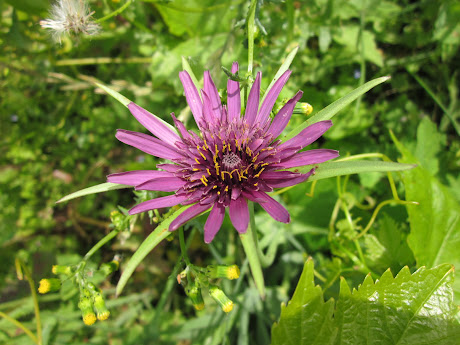Book Review: Two From Hillier and a Glimpse of the Garden
I had the good fortune recently to be invited to the Sir Harold Hillier Gardens in Hampshire to help them celebrate Hillier's 150th birthday. This took the form of a double book launch, a scrummy lunch and a tour of the gardens, plus a side trip to one of the nurseries.
The latter will feature as part of my Chelsea Sneak Previews in a week or so. Today, it's time to have a look at what I brought home in my goody bag...
This is a completely updated (paberback) edition of a garden book classic. 1,500 new plants have been added and apparently the authors (John Hillier, Roy Lancaster, plus James Armitage and the botany team at the RHS) had plenty of debate about which new plants merited inclusion.
The original manual was based on Hillier's catalogue and this edition retains that feel because there are no pictures. If you are used to using the RHS Plant Finder, this shouldn't be a problem.
This is the manual to research likely trees and shrubs for the garden, but gardeners like me will probably need to reference other material and visit gardens to see how it would look in our chosen setting.
The opportunity has been taken to resolve discrepancies in taxonomy and naming, plus include Plant Finder information such as which plants have the Award of Garden Merit. Apparently the mother of all spreadsheets was used to pull all of this information together - 13,000 plants.
At first glance, the lack of pictures may make you think this is a dry and dusty volume, made redundant by the information easily found at the click of a computer button. It's not - I've enjoyed diving in at random to find the personal plant descriptions plus the who, where and when a plant was discovered, or how it was bred or discovered via a sport. This kind of information isn't found that easily online.
How I wish I'd known about and consulted the chapter at the end called Trees and Shrubs in Landscape and Design when we moved here as it's is a great starting point for choosing those lasting plants which form the anchor planting for a garden.
This is a work of love, and a detective story lasting for over 10 years. Possibly only a family member (by marriage) would have the staying power to research and travel so widely in order fit all the jigsaw pieces together to tell the story of a 5 generation garden business.
Jean Hillier's starting points were the dusty filing cabinets which housed the Hillier archive and the family tree which traced the family back to the eighteenth century, around a century before Edwin Hillier founded the company in 1864.
From there her researches took her to many places, including here in Chippenham as she consulted the records residing in the Wiltshire and Swindon History Centre.
This is a rich mixture of social history, plantsmanship and how a simple thing like giving a man an education allows him to pull a family out of poverty. I was surprised to learn that education of the poor was very controversial in the 1800s. Today Hillier is a name which dominates the horticultural world, yet it had very humble beginnings 150 years ago. It's also an inspirational story - showing how passion, hard work and ambition can lead to great things.
As well as Jean Hillier's words, there are plenty of photographs and illustrations to help tell the story. I'm finding myself increasingly drawn to the stories of the people behind the plants I see on garden visits or have in my garden, so it's a real pleasure to have this book.
If you love plants, garden history and programmes like Who Do You Think You Are?, then you will enjoy this book too.
The latter will feature as part of my Chelsea Sneak Previews in a week or so. Today, it's time to have a look at what I brought home in my goody bag...
This is a completely updated (paberback) edition of a garden book classic. 1,500 new plants have been added and apparently the authors (John Hillier, Roy Lancaster, plus James Armitage and the botany team at the RHS) had plenty of debate about which new plants merited inclusion.
The original manual was based on Hillier's catalogue and this edition retains that feel because there are no pictures. If you are used to using the RHS Plant Finder, this shouldn't be a problem.
This is the manual to research likely trees and shrubs for the garden, but gardeners like me will probably need to reference other material and visit gardens to see how it would look in our chosen setting.
The opportunity has been taken to resolve discrepancies in taxonomy and naming, plus include Plant Finder information such as which plants have the Award of Garden Merit. Apparently the mother of all spreadsheets was used to pull all of this information together - 13,000 plants.
At first glance, the lack of pictures may make you think this is a dry and dusty volume, made redundant by the information easily found at the click of a computer button. It's not - I've enjoyed diving in at random to find the personal plant descriptions plus the who, where and when a plant was discovered, or how it was bred or discovered via a sport. This kind of information isn't found that easily online.
How I wish I'd known about and consulted the chapter at the end called Trees and Shrubs in Landscape and Design when we moved here as it's is a great starting point for choosing those lasting plants which form the anchor planting for a garden.
Jean Hillier's starting points were the dusty filing cabinets which housed the Hillier archive and the family tree which traced the family back to the eighteenth century, around a century before Edwin Hillier founded the company in 1864.
From there her researches took her to many places, including here in Chippenham as she consulted the records residing in the Wiltshire and Swindon History Centre.
This is a rich mixture of social history, plantsmanship and how a simple thing like giving a man an education allows him to pull a family out of poverty. I was surprised to learn that education of the poor was very controversial in the 1800s. Today Hillier is a name which dominates the horticultural world, yet it had very humble beginnings 150 years ago. It's also an inspirational story - showing how passion, hard work and ambition can lead to great things.
As well as Jean Hillier's words, there are plenty of photographs and illustrations to help tell the story. I'm finding myself increasingly drawn to the stories of the people behind the plants I see on garden visits or have in my garden, so it's a real pleasure to have this book.
If you love plants, garden history and programmes like Who Do You Think You Are?, then you will enjoy this book too.
.jpg)

.jpg)











Thanks I'd not heard this was updated so I'm off to see if the library might get it in. Great post!
ReplyDeleteSo glad you found it useful Wee Lass - it's only just come out so fingers crossed your library has it
DeleteThe Hillier gardens are wonderfully inspiring, we try to pop in whenever we are passing. Your second book sounds a good read, I will have to look into that one, with a birthday coming up soon, I could drop a few hints!!
ReplyDeleteHillier have published this one, so their website is a better bet for obtaining it - add that to your hint if the usual sources don't have it ;-)
DeleteMagnolia Walk looks absolutely beautiful, with such a lovely house at the end. The book sounds really interesting, with a lot of hard work having gone into it. I'm glad you enjoyed your visit.
ReplyDeleteMy last visit was in August so it was great to see it in Spring :-)
Delete